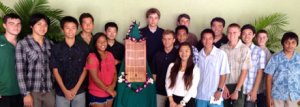PBL Meets WWII: A History Lesson to Remember
A project-based learning history unit about World War II sparked deep student engagement.
There are many, many, many things that are more exciting to a teenager than history class. That's why I wanted to create a lesson plan that would generate interest -- and therefore encourage engagement -- in history among my high school sophomores.
When I begin to plan out a project-based learning opportunity for my students, I usually follow the same brainstorm path. Of course, this path could be followed by your students as well, in order to give them voice and choice in their curriculum.
- Generate an essential question.
- Identify the content and/or skills you'd like the students to improve upon.
- Consider the product(s) the students will create (which could be anything from a research paper or a mock trial to a display or a performance).
- Name community members who would be beneficial to approach as guest speakers or mentors for the students' work.
- Generate a public audience for the product(s), which can be on a small level (students in the same school but not in the same class) or a large level (community members from outside of the school's boundaries).
Once the opportunity has been brainstormed, I assemble a project sheet to distribute to my students. Every good project sheet should include:
- A title for the project
- An overview (a short and simple description of the project)
- Skills (a concise list of the standards/skills on which the project will focus)
- Parts (bullet points of the requirements the students will be expected to complete en route to their final product)
- Final product(s) (a detailed explanation that could include a rubric or list of elements that will be examined when graded)
- A timeline (general or precise dates for the completion of the parts)
A Night to Remember
I created a WWII project called "A Night To Remember" to bring history to life for my high school sophomores. I planned to fulfill some WWII content requirements through looking at the internment of Japanese Americans with a public student work showcase. What I did not plan for was how this project stretched and grew to include a fundraiser and dedication plaque that affected lives outside of our class.
Here's what I scaffolded:
- Background research and two guest speakers, in order to give my students a good understanding of the topic through various perspectives.
- A field trip to a local site pertaining to our topic, to deepen my students' connection to the topic.
- The task of collecting poetry written by those who experienced internment during WWII, and absorbing their feelings by performing the poetry, which would cultivate public speaking skills.
There were several results I didn't expect: The students fundraised enough to gift a field trip to another school so that they could perpetuate awareness of the topic they'd learned about.

They also discovered that two alums of their own school had been detained during WWII. They commissioned a plaque to leave a lasting legacy regarding the work they did on this historical topic, but also to commemorate the two interned alums, and gained drafting and revision skills in creating the plaque.
In addition, the students held an unveiling ceremony for the plaque in front of their principal, a handful of members from the Japanese Cultural Center of Hawaii, teachers, school board members, a federal judge with a personal connection to internment, a former detainee, and a few of the relatives of the individuals commemorated on the plaque.
Students realized that this project was not just about their own education, but about educating future students, and creating an honorable and/or meaningful experience for many community members.
The poetry showcase was an exciting experience for the students, who accomplished bringing history to life for the audience members through their compelling recitations. The fundraiser gave the students purpose, and helped them to be members of the community. The commemorative plaque made my students proud of themselves. Project-based learning truly made history unforgettable for my students.
